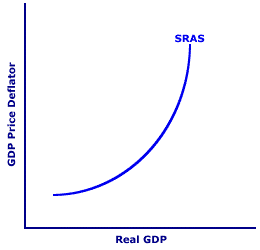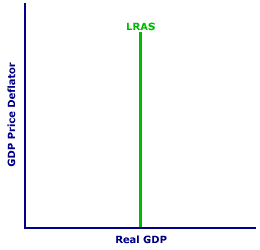
|
|
AP: The abbreviation for average product, which is the quantity of total output produced per unit of a variable input, holding all other inputs fixed. It is found by dividing total product by the quantity of the variable input. Average product, abbreviated AP also goes by the alias of average physical product (APP), so don't be confused by the extra term (physical).
Visit the GLOSS*arama
|
|


|

|
                           CHANGE IN REAL PRODUCTION: The movement along the short-run or long-run aggregate supply curve caused by a change in the price level. A change in real production is caused ONLY by a change in the price level. This is one of two changes related to aggregate supply. The other is a change in aggregate supply. A change in real production is comparable to a change in quantity supplied. A change in real production for short-run aggregate supply means real production changes with a movement along a given short-run aggregate supply curve. However, the term "change in real production" is also used for movements along a given long-run aggregate supply curve, even though real production does not actually change in the long run. To better understand the meaning of a "change in real production," note the difference between aggregate supply and real production. Aggregate supply is the whole range of price levels and real production while real production is a specific quantity of production at a specific price level. Aggregate supply is the entire aggregate supply curve, while real production is a specific price level-real production point on the aggregate supply curve.So what does it mean to add the phrase "change in" to aggregate supply and real production? A "change in" real production means that a NEW price level-real production combination is identified on the existing aggregate supply curve. In contrast, a "change in" aggregate supply means that the entire aggregate supply curve changes, moves, or shifts; that the whole range of price levels and real production amounts changes. | Change in SR Aggregate Supply | 
| Change in LR Aggregate Supply | 
|
The exhibit to the right displays two curves--the short-run aggregate supply curve (SRAS) in the top panel and the long-run aggregate supply curve (LRAS) in the bottom panel. A change in real production is seen as a movement along either curve. To illustrate this change, click the [Price Level and SR] button in the top panel or [Price Level and LR] button in the bottom panel. The click of either button illustrates a movement along the corresponding curve. While the phrase "change in real production" is used for both curves to indicate a movement along the curve, because real production is constant in the long run, real production actually '" changes" only by moving along the short-run aggregate supply curve.The contrasting change is a change in aggregate supply--a shift in the aggregate supply curve. To illustrate how this transpires, click the [Determinant and SR] button in the top panel or the [Determinant and LR] button in the bottom panel. Upon clicking either button, the corresponding aggregate supply curve shifts to the right, illustrating an increase in aggregate supply, and more generally, a change in aggregate supply. Why is this difference so important? The answer is as simple as cause and effect. The aggregate supply curves are used (together with the aggregate demand curve) to explain and analyze macroeconomic events, especially business-cycle instability. The sequence of events follows a particular pattern. - First, a determinant (of either aggregate demand or aggregate supply) changes.
- Second, this determinant change causes one of the aggregate supply curves or the aggregate demand curve to shift. An aggregate supply determinant change causes a shift in one of the aggregate supply curves and an aggregate demand determinant change causes a shift of the aggregate demand curve.
- Third, the change in aggregate supply or aggregate demand causes an imbalance in the aggregate market (an economy-wide shortage or surplus). The aggregate market is in a temporary state of disequilibrium.
- Fourth, the economy-wide shortage or surplus causes the price level to change.
- Fifth, the change in the price level causes a change in aggregate expenditures and possibly real production (in the short run).
- Sixth, the changes in aggregate expenditures and/or real production eliminate the shortage or surplus and restore equilibrium.
The key conclusion is that aggregate supply (and aggregate demand) determinants, which induce changes in aggregate supply (and aggregate demand), are the source of instability in the aggregate market. The change in the price level, which induces a change in real production (and aggregate expenditures) is the means of eliminating the instability and restoring equilibrium.

Recommended Citation:CHANGE IN REAL PRODUCTION, AmosWEB Encyclonomic WEB*pedia, http://www.AmosWEB.com, AmosWEB LLC, 2000-2024. [Accessed: April 29, 2024].
Check Out These Related Terms... | | | | | | |
Or For A Little Background... | | | | | | | | | | | | |
And For Further Study... | | | | | | | | | | | | | | | |
Search Again?
Back to the WEB*pedia
|



|

|
|
In the Middle Ages, pepper was used for bartering, and it was often more valuable and stable in value than gold.
|

|
|
"Something in human nature causes us to start slacking off at our moment of greatest accomplishment. As you become successful, you will need a great deal of self-discipline not to lose your sense of balance, humility and commitment." -- H. Ross Perot
|

|
AACCLA
Association of American Chambers of Commerce in Latin America
|

|
|
Tell us what you think about AmosWEB. Like what you see? Have suggestions for improvements? Let us know. Click the User Feedback link.
User Feedback
|


|


